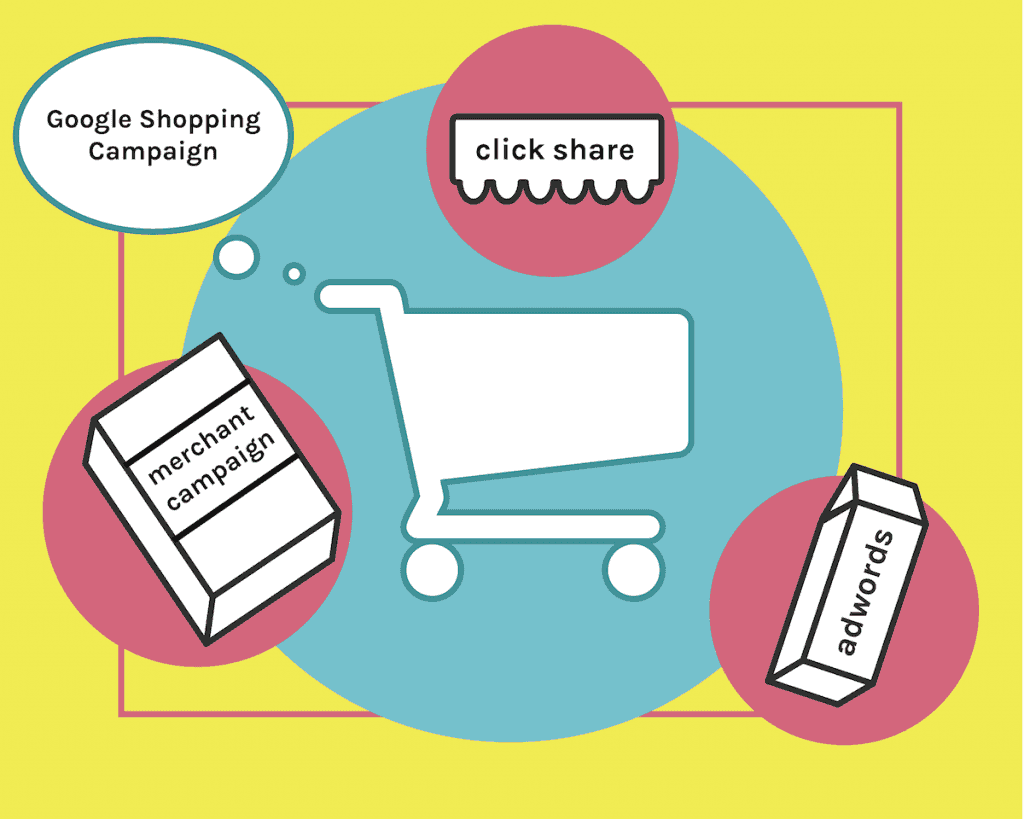A Crash Course in Google Shopping

So, you’ve decided to take on Google Shopping. Whoo! With this next step, you’re now on your way to growing your business. Just like how you prepare for grocery shopping by making a list, it’s also important to make a game plan for Google Shopping. Before you dive in, read these tips to help you get acclimated.
Setting up your account
Prior to advertising your products, you need to make sure that you have a Merchant Center linked to your AdWords account. To do so, you will have to create a data feed and register that data feed to your Merchant Center. Since a data feed discussion could be a ten-post blog series in and of itself, check out Google’s explanation for a complete, technical walkthrough to setting up your feed.
Once your data feed is set up, you need to create a campaign structure that makes sense for your business. There are certainly multiple ways to organize a shopping campaign, but typically a good rule of thumb is to structure your account in a way that closely resembles the way your business is structured.
Organizing your campaign
Say you own a business that sells shippable pizzas along with pizza-related merchandise. (If you actually do own this business, please give me a call. I would be a very loyal customer). In this case, you would not want to group your shippable pizzas in with your pizza T-shirts, so you would split those into different ad groups. You could also divide them into different campaigns so they do not share the same budget and are completely independent of each other.
I cannot emphasize enough that there are many ways to slice–pun intended–your account. The most important thing is that the structure of your shopping account makes sense to you. Regardless of which way you structure the campaigns and ad groups, it is important to distinguish the products by product groups.
Back to our pizza example. You will want to be able to separate pepperoni pizzas and cheese pizzas into their own product groups since they have different production costs and conversion values. This will allow you to bid up or down accordingly for these different types of pizzas. The same thing would apply to your pizza merchandise. You would want to put your T-shirts, keychains, and blankets (my dream) in separate product groups and then, if applicable, segment by color, brand name, or other attributes.
Optimizing your shop
Okay, so you’ve set up your data feed and your shopping campaign is now organized in a way that makes sense. Now what? It’s time to optimize.
“Click share” is a unique metric Google Shopping has that Google Search does not. Click share is defined as the number of clicks that you have received divided by the estimated number of clicks you could have received given the total number of impressions that you were eligible for. It’s a good indicator for the health of your product groups.
If your click share is low, you will want to bid up to make sure that you are getting more clicks so you can increase your chances of showing your product to people who would be likely to convert. Keep in mind, however, that click share takes into account the overall quality and relevance of your ad.
You will want to make sure that your data feed is optimized in terms of quality while also making sure that your bids are competitive enough to receive impressions and, by extension, clicks.
Besides Click share, Google Search and Shopping are pretty much the same. In other words, treat your product groups similarly to how you would treat your normal search keywords. You want to ensure that you are maintaining an efficient cost/conversion and are pausing product groups that are not converting or are unprofitable.
If you see that a product group is indeed very profitable, you can check search impression share as well as click share to see if you can scale that specific product group. If, for example, your pepperoni pizza product group has a low click share but is extremely profitable with a low cost/conversion and high conversion rate, you will want to bid up to try and make those pizzas even more profitable. Don’t be afraid to raise bids in shopping! CPCs are generally cheaper on shopping than they are on search.
What now?
Google Shopping is changing the way that businesses are connecting with consumers. Google Shopping allows people to compare prices and merchants much more easily than Search ever could. Once you’re all set up, keep optimizing, don’t be afraid to spend, and enjoy that increased ROI and profit!
Want to optimize your paid search accounts, too? Never fear! Read my blog post on creating the perfect paid search campaign. If you’re interested in paid search and Google shopping for your business, learn more about how we can help.
—
Do you have any Google Shopping tips? Would you love a pizza/pizza merch shipping company as much as us? Tell us! Email us at info@perfectsearchmedia.com or tweet us @Perfect_Search.
